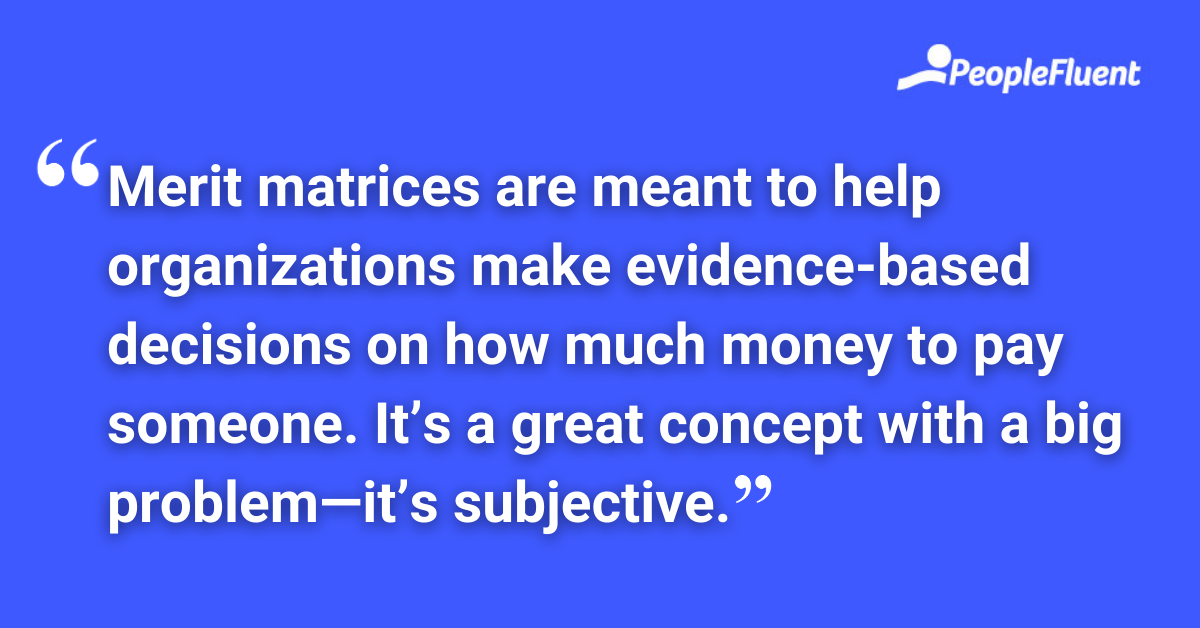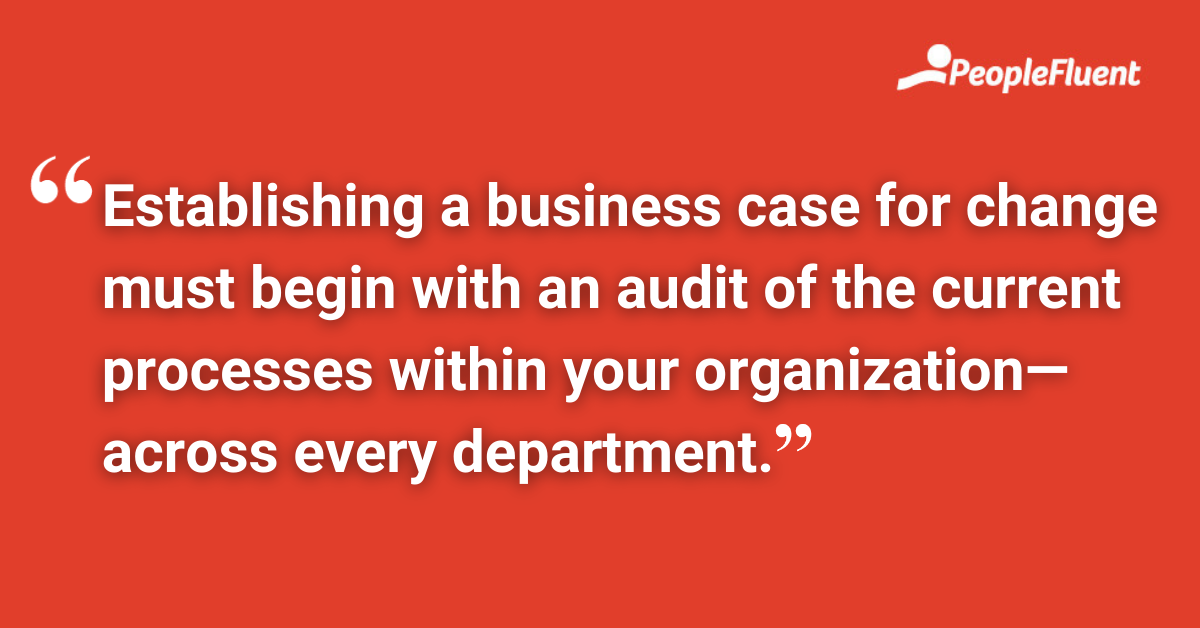Published: May 25, 2022Time to read: 8mins Category: Compensation
Why It's Time to Go Beyond the Merit Matrix
The merit matrix has traditionally been a significant part of the compensation planning process. But it’s not perfect. PeopleFluent Managing Director, Stephen Bruce, sat down with Trish McFarlane of the HR Happy Hour podcast to shed light on why the merit matrix alone is no longer a viable option for enterprises developing and deploying efficient compensation planning and salary administration.
Developing a compensation strategy is a time-consuming project. The outcome of these strategies can impact every employee in your organization and have a material effect on the business. Considering the delicate and subjective nature of employee wages, it’s essential to have a fair yet competitive mindset when building your compensation and rewards programs. In addition, your compensation plan should take into account the employee’s position and performance as well as your company’s budget.
People are a company’s greatest expense—with billions of dollars misspent trying to get it right. That’s enough of a business case for change. Managers must work in concert with their HR business partners to ensure the fundamental elements of a compensation plan are rooted in data and structure. Without these two essential components, leaders will find it difficult to justify such a plan to executives, compensation committees, and their board of directors.
In this blog post, we examine the limitations of the merit matrix—a distribution model originally developed with the intent to drive a pay-for-performance strategy, or merit pay. We also offer strategies to build a business case for change and ensure a more effective compensation model in your organization.
YOU MIGHT ALSO LIKE | ‘6 Ways to Align Compensation With Organizational Goals’
A Brief History of the Merit Matrix
The merit matrix design was developed with the objective of providing pay raises based on how well an employee is performing and how competitive their salary range is compared with the current market rate. From a data-driven perspective, this isn’t a misguided starting point.
However, the fundamental premise allows for too much of the discretionary decision to be utilized in a tool that doesn’t allow for any type of review. In other words, there aren’t enough configurables within the model to account for variables in real-life scenarios. Herein lies a structural design flaw. Companies are overspending because they aren’t considering compensation as a strategic reward tool. With this understanding of a flawed tool that’s still in use, how can we address pain points with leadership to begin developing a structured approach?

Addressing Pain Points With Leadership
Merit matrices are meant to help organizations make evidence-based decisions on how much money to pay someone. It’s a great concept with a big problem—it’s subjective. People tend to have an emotional reaction when it comes to money, so a subjective process will be hard for some employees to accept when managers are attempting to justify their pay raise decisions. Not only that, but roughly one in three employees already think they aren’t paid fairly compared to their coworkers. Using a subjective tool like a merit matrix as the only means of determining pay increases won’t help build employee trust.
While each organization views things through its own lens, there should be specific data elements at the forefront of building a compensation and rewards plan. Loss impact should be a huge driver in any leader’s toolkit. Additional key data elements to consider are:
- Revenue generation
- Cost savings
- Productivity
- The complexity of the role compared to other positions
- An employee’s potential for promotability
This leads to the issue of employee retention from a manager’s perspective. For example, certain roles in a company require complex skill sets. Consider the skills required for a software architect. Now consider how difficult it is to hire and retain an experienced software architect. Only taking into account the performance rating and market pay is extremely limiting in this regard, especially when a great software architect could grow with the company and eventually become a Chief Technology Officer. A merit matrix doesn’t account for driving value to this role versus other positions.
RELATED READING TO DOWNLOAD TODAY | ‘Learning is the Engine for Talent Mobility, Skills are the Fuel’
Develop a Structured Approach to Compensation Planning
Since managers work more closely with frontline employees than business leaders and HR partners, you have to allow for discretion. A manager’s input is another important factor in determining an employee’s pay. Organizational leaders will hear from several managers from the many departments within the organization. That’s a lot of input to organize! As such, the process must be more structured.
A merit matrix doesn’t offer this amount of configurability. Since consistency is absolutely necessary to plan and deploy fair compensation at scale, establishing specific data elements can help keep things homogenous.
Having a structured approach for managers and HR leaders to monitor, manage, and report compensation data is paramount. This helps business leaders demonstrate a consistent method for distribution when meeting with compensation committees and executives. It’s all about ensuring the money gets to the right employees, which is ultimately the crux of building an effective compensation plan. Without the proper workforce data in place for leaders to audit manager recommendations, organizations can easily misallocate and overspend millions of dollars during the salary administration process.
KEEP READING | ‘How Data About Your High Performers Is the Key to Fairer Compensation & Greater Retention’

Building the Business Case for Compensation Planning Change
Although your HR business partner may be meeting with your managers and leaders on a correction basis, ensuring consistency in the distribution of pay isn’t possible without clear, specific data elements. Leaders want to drive pay decisions based on elements that impact performance. They want to provide market pay that is competitive. However, when given a merit pool of 3%, for example, many leaders may begin to feel constricted.
In reality, the approach must be a top-down strategy. Establishing a business case for change must begin with an audit of the current processes within your organization—across every department. Managers must be allowed to continue providing discretion while using the set data elements provided from a highly-configurable tool. Going back to the software architect example and considering the potential for promotability—a main data element—leaders should ask questions like:
- Are they assigned to critical projects?
- How have they historically performed when working with peers and others?
- How quickly is this individual developing?
- Should I establish a program to help develop the individual?
RELATED RESOURCE | ‘RFP Checklist for Compensation Pros: Know What to Ask to Get Exactly What You Need’
Leverage Manager Input and Data Elements
How leaders deliver pay increases and further invest in their workforce depends on specific data elements. Furthermore, leaders need to invest in their managers. Managers will continue to use the policies and systems only to the extent that they are educated on how to deploy them.
Regardless of the distribution model, there must be a mathematical element as it relates to an individual deserving the level of pay or compensation rewards they receive. Setting clear guidelines for your top-level management and truly educating them on the distribution model and the set of data elements can help guide the process and allow them to provide discretion at the same time.
By challenging the existing data, you can begin remodeling it to find inconsistencies. Finding discrepancies, such as employees in a ‘high’ range from a market-pay perspective who still get the same pay as individuals in the ‘low’ range, can help you begin the business case for change.
Establishing this case with senior management or the board of directors will require you to present fundamental issues with your distribution model. Start by laying out inconsistencies, demonstrating a lack of data elements, and making recommendations on which elements should be required before any percentage of the pool is distributed.
DISCOVER MORE | ‘Hire Great Talent Without Losing Your Shirt [Infographic]’
Final Thoughts on the Merit Matrix
When it comes to compensation planning, don’t be afraid to let leaders know that you need a process because the one you have isn’t meeting the necessary requirements and is causing you to overspend each year.
To learn more about why leaders need to move away from using the merit matrix, listen to the HR Happy Hour Podcast with guest speaker, PeopleFluent Managing Director, Stephen Bruce.
Note: This article was originally published in February 2020 and has been updated with new information.
Discover How to Reward People and Stay Competitive
PeopleFluent software provides the tools to help you plan and execute complex compensation plans, so you keep within your budget while attracting, rewarding, and retaining top performers.